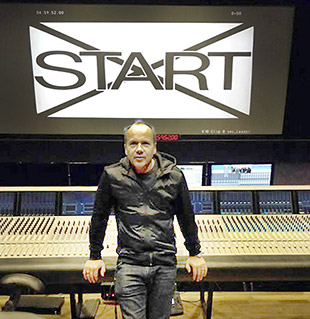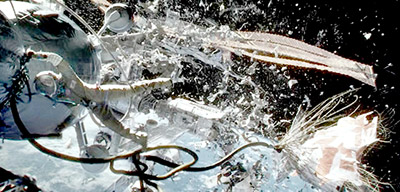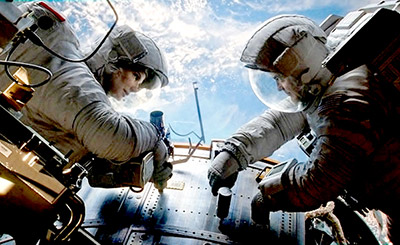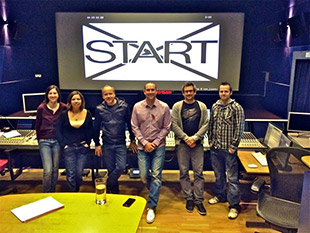![]() One of the big film events of 2013, Gravity is a genuinely exciting event in cinema viewing, and possibly even more so in cinema craft – from cinematography, to visual effects, to sound...
One of the big film events of 2013, Gravity is a genuinely exciting event in cinema viewing, and possibly even more so in cinema craft – from cinematography, to visual effects, to sound...
Starring Sandra Bullock and George Clooney, and directed by Alfonso Cuarón, the film tells the story of a disastrous space shuttle mission to service the Hubble telescope that leaves Stone and Kowalsky stranded in space.
 Collaborating with Cuarón on the audio for Gravity as Sound Designer and Sound Supervisor was Sound 24’s Glenn Freemantle. He describes the film as ‘a survival journey... an action adventure but with a heart and a soul to it.’
Collaborating with Cuarón on the audio for Gravity as Sound Designer and Sound Supervisor was Sound 24’s Glenn Freemantle. He describes the film as ‘a survival journey... an action adventure but with a heart and a soul to it.’
Freemantle has been Sound Supervisor on some amazing projects, not least those attributed to his long-standing partnership with Director Danny Boyle (Trance, 127 Hours, Slumdog Millionaire, Sunshine). He has been delighted with the enthusiastic response to this. One director he worked with recently called him and said ‘I couldn’t believe it. I was holding on to the edge of my seat and I was moving forward. The ride is unbelievable... I was overwhelmed.’
‘That’s what people are experiencing,’ says Freemantle. ‘It’s a great story, it looks amazing, and it sounds absolutely amazing (obviously), but it’s also an event... the 3D, the sound – it’s completely around you, it moves all the time, it’s an immersive experience...’
Freemantle is a vocal advocate of the Dolby Atmos object-based 3D sound system, and Gravity is, of course, an ideal vehicle. The film, Freemantle notes, is an ‘event,’ best experienced, ‘In Dolby Atmos, with the biggest picture.’ However, the team are quick to point out that the 7.1 is also something special because, from the start, the project released them from well-trodden rules of film sound.
Early Start
Freemantle and the core audio team were involved in Gravity from December 2010, when they did the sound design and temp mix on a 45-minute ‘pre-vis’ for the film studio. After that, the film went into production proper.
‘It starts off super-dynamic, super-loud,’ says Freemantle, ‘Between the music and the sound design - the distortion, the radio signals, the build-up... The whole thing builds to a massive crescendo right at the beginning... In Atmos we can build it up through all the speakers. It goes from front to back, to the sides, then you bring all the subs up, and then we reverse the sound back into itself at the end. It’s unbelievably loud, then the film suddenly goes silent as it cuts to a massive, wide shot of space. After that, the sound builds up again very gradually.’
The film’s highly dynamic content is one of the things that characterises its sound, but for Freemantle there were a couple of fundamental treatments, decided on early in the production process, that really set it apart.
First Principals
Space is a disorientating place, with no up or down. To reinforce this, Cuarón and Freemantle chose to use all-round panning for all sources, including dialogue. This extended, for example, to the position of the mission control voice from earth, relative to the on-screen action. ‘Wherever earth is, the voice will come from there,’ he says. ‘So if you move around, the voice will move around.
‘Wherever Kowalsky is or Stone is there’s a relationship between them and the earth and also between each other - the voice and whatever is attached to them, such as the radio... All characters are relative. That happens with the dialogue, it happens with the music, it happens with all the sound design... Everything.’
The Sound of Space
The next fundamental issue the team had to deal with was the inconvenience of sound’s behaviour in a vacuum. In other words – there is no sound in space. As there is quite a lot of the film set out in the void, Freemantle had to find a way of bringing sound design to bear without completely ignoring basic physics.
This inspired the idea to work with the atmosphere inside the spacesuits and, more radically, the idea of touch and vibration. ‘When she [Stone] touches something you hear it through her suit, through vibration. Sound travels by vibration and there’s air in the suit.’
Once the concept was decided upon, it was necessary to gather the raw material. The idea of touch and vibration informed not only the actual recorded objects and environment, but the methods of recording as well. Contact mics were employed for most items and the emphasis was on capturing physical vibrations.
Good Vibrations
A significant proportion of the sources were the robotics, machinery, and tools used on the space shuttle and the space station. With a handy NASA source for advice, it turned out that a good place to start was in the car manufacturing and medical robots industries. The team spent a day at General Motors in Luton – in the facility where they test and prepare the tools. ‘We got there about 8am,’ says Freemantle, ‘And finished about 5.30pm. We had carte blanche – anything that was mechanical, moving, we stuck mics to them and recorded them.’

The team also visited a medical equipment manufacturer and recorded those machines and tools. Freemantle: ‘Medical stuff is super cool... It’s really refined, really expensive. We recorded all of their tools - the stuff they chop your legs off with!’
There was experimentation with a geophone – a transducer used in oil exploration and seismic measurements, and normally used for recording ground displacement – as well as recordings using coil pickups, capturing the electromagnetic fields of various electrical devices, including power tools.
They also spent time in Paris with Foley Artist Nicolas Becker, working further on the concept of touch and vibration. One idea was to put a guitar in water and use the resonant body to transmit vibrations for various objects: ‘We put hydrophones (DPA 8011) in the water, contact mics around the outside, and contact mics on the guitar itself, and then we would run different things down it.’
This groundwork became the basis of Gravity’s soundtrack design. ‘You take these sounds,’ says Freemantle. ‘The you add add more layers – maybe with sub on them, and some HF detail, then we pitch, stretch, and filter them where needed to help create movement.’ The team used various high-end ‘detail’ layers for different sources to help counter the dulling effect of touch and vibration emphasis.
‘The sound gives you a great idea and then you develop it to what the picture wants,’ continues Freemantle. ‘The picture has its own needs. You have to mould and manipulate that sound each time. Each movement - smaller movements, bigger movements – will need a bit of filtering, a bit of work. It’s everything that you do anyway in making a new film, but from a new reference point.
‘Its not all about throwing loads of plug-ins at something... It’s all about the concept, the idea, and following that through the film – from a perspective. That creates the design of the film.’
In order to establish perspective, Freemantle had to put the audience inside Stone’s suit. ‘At the beginning of the film, even when she’s not talking, she’s breathing. That acts as your contact with her, even from a distance. For example, at one stage she is tethered to Clooney and they get pulled apart. You feel that force... So you’re always in contact.
Freemantle is full of praise for Nina Hartstone’s work on dialogue, and specifically the emotion she managed to get into the breath sounds. ‘We also used a heartbeat. It’s very subtle sometimes; it comes and goes, but it creates an emotional content – her anxiety.’
 A third element of anxiety is the use of a radio tuning effect, so create the almost subliminal notion that someone might be there. ‘There’s always a chance,’ says Freemantle. ‘It’s the sum of all these elements, plus the music, that create a dynamic in Stone’s anxiety and emotions. ‘And that’s what collaboration is about... She’s in peril. It’s the sum of all the parts working together.’
A third element of anxiety is the use of a radio tuning effect, so create the almost subliminal notion that someone might be there. ‘There’s always a chance,’ says Freemantle. ‘It’s the sum of all these elements, plus the music, that create a dynamic in Stone’s anxiety and emotions. ‘And that’s what collaboration is about... She’s in peril. It’s the sum of all the parts working together.’
Freemantle also mentions the composer Steve Price’s music and its important part in the film. This may well be because music in film tends to be an emotional illustrator, rather than being part of the reality – there’s no music in space either, but its existence is probably questioned less than impossible sounds from on-screen sources.
Also, Freemantle and price have worked together successfully several times before, and this on-going collaboration comes with many benefits. The pair communicate throughout the production’s life cycle, ensuring that the music and sound design compliment each other perfectly. This requires flexibility on both sides, but is also a direct result of a constructive, collaborative relationship.
Total Mass
An early sequence in the film serves to illustrate this idea of all elements - touch, vibration, breathing, heartbeat, radio, and music – coming together. Debris hits the Hubble Space Telescope while Stone and Kowalsky are working on it. A massive collision is treated in silence as Stone is not attached to the colliding hardware – something Freemantle points out can be much more effective than even the biggest explosion: ‘Sometimes silence with something huge is more frightening... especially if you’re playing it off against other things.’
Music then serves to ‘play’ the collisions while the sound design focuses on Stone’s breathing, and heart rate to induce anxiety. Then Stone and Kowalsky become detached and the sound can use the radio ‘device’ to ramp up the stress. ‘The great thing about that,’ explains Freemantle, ‘Is that the sound is not clashing on the screen.... A traditional action movie would have all that stuff going off, plus the contact with the person. That’s very difficult to listen to. In this you’ve got complete contact with her and her peril... You’ve got her heart rate, her breathing, the radio, things blowing up in silence around her.’
Earth Moves
Getting the original ideas and concepts to the mix stage wasn’t nearly as difficult as it might have been, had Re-Recording Mixer Niv Adiri not also been part of the Sound Design team from the start.
‘We were pre-mixing it constantly through the process,’ explains Adiri. ‘So the actual sound was there from a very early stage... That gave us the opportunity to develop the sound with Alfonso [Cuarón] in the room to the point where he was very happy with it. So actually once we got to the mix stage, it was all approved – he was very happy.
Irrestible Force
 Much of the soundtrack for gravity can be wholly characterised with the original straightforward acknowledgement that there is no sound in space. Then add the idea that there is no up or down and no forward or back, then all that is left is to rewrite a few of the basic rules of film sound.
Much of the soundtrack for gravity can be wholly characterised with the original straightforward acknowledgement that there is no sound in space. Then add the idea that there is no up or down and no forward or back, then all that is left is to rewrite a few of the basic rules of film sound.
One rule remains though – it doesn’t matter what you do, as long as you don’t alienate the audience with ‘unreality’; every plot, however fictional, has its own reality that must be established from the beginning. Adiri: ‘If you sell the concept early and it’s a concept that works, you have to go for it. You can’t say ‘I won’t do it on this cut’ or ‘I won’t do it here’... just go for it. People get used to it and buy into it.’
After the concept came the raw materials, which Freemantle was very keen to get right, for good reason: ‘It’s like a good meal isn’t it?’ He explains. ‘You go to the market, you buy great ingredients, then you refine it. And then you add other things.. you might put on a little bit of sauce!
Is Gravity an audio-category Oscar winner? Few would question its candidacy, and I’ve heard several independent, unsolicited opinions to endorse that. It certainly has all the ingredients. In any case, it’s an absolute ‘must-see’ for anyone who has even a passing interest in film sound, and film craft.
In the UK, it’s a shame that the Atmos options are still a little limited. At the time of writing, while the Empire, Leicester Square, is undergoing refurbishment (IMax screen install – the other seven screens are still open) the only London option is the new Olympic Studios Cinema. Other UK venues are the Cramlington Vue cinema, Northumberland, and the Glasgow Fort Vue Cinema, Scotland.
This post first appeared on The Audio Production Network, authored by Paul Mac.